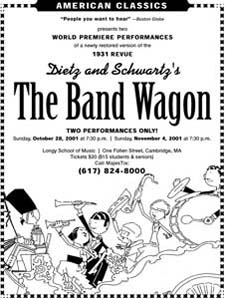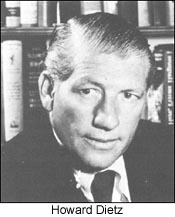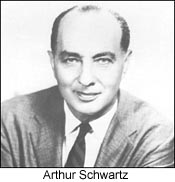 |
 |
| A donation will help the work of American Classics |
|
American Classics - The Band Wagon
Please click here to listen to selections from the show. The 2001 performances of The Band Wagon on the American Classics Musicals in Concert series were the first revival of this revue, long considered one of the best ever written. In 1931, The Band Wagon, under producer Max Gordon, brought together all the traditional elements of the revue format: skits, songs, and dance. One of The Band Wagon's most innovative features was a revolving stage, which was perhaps utilized best in the first act finale, "I Love Louisa" (see photo). At a time when revue scores were written by many writers, The Band Wagon had a score written entirely by the team of Howard Dietz and Arthur Schwartz. Dietz also wrote the skits in collaboration with the brilliant George S. Kaufman. It brought together an amazing collection of performing talent, each with their own strengths, which were utilized brilliantly by Dietz, Schwartz, Kaufman, and choreographer Albertina Rasch. Stage Director and Lighting Designer Hassard Short, Set Designer Albert R. Johnson and Costumers Kiviette and Constance Ripley created sparkling sets and costumes that set off the various scenes. Helen Broderick and Frank Morgan, both to become staples of Hollywood, she as the Eve Arden-type foil for the leading lady, he as a series of bumblers including the Wizard of Oz, anchored the comedy. Tilly Losch was a brilliant ballet-style dancer, who neither acted nor sang, whose talents shone in two numbers, "The Flag" (see photo) and "The Beggar Waltz," along with the song "Dancing in the Dark" which had an extensive dance sequence. Philip Loeb, a respected actor and later a director, filled many of the character roles in the sketches. Fred & Adele Astaire, for whom the Gershwin brothers had written Lady, Be Good! and Funny Face, were one of Broadway's most popular brother/sister song-and-dance teams. For this show they brought their act to the stage for the last time, as Adele would leave the show in 1932 to marry Lord Charles Cavendish and take up residence in Ireland. The show's last scene, "The Five Star Finale," presented personas the Astaires had used for many years -- he the serious brother, she the gadabout sister. They were both given a chance to have fun in two of their songs, "Hoops" (see photo) (which ended with their celebrated "runaround" exit -- they literally "ran around" the stage and then dashed off, always to great applause) and "Sweet Music" (in which Fred is irresponsible and Adele tries to get him to take life seriously). Fred also got to don what would become his trademark top hat, white tie and tails in "New Sun in the Sky" and again in "White Heat" (this time with Adele also in men's evening dress).
– Benjamin Sears "Bradford Conner and Benjamin Sears did all the work [of reconstruction] and Sunday night an audience at the Longy School had all the fun. Witty pianist Margaret Ulmer stood in for a pit band. There was a cast of 14 talented people, many of them skilled in evoking the style of the period; they were directed with panache by David Frieze. There were some good theatre voices and all the others know how to put over a song in a genre that doesn't require major voices. It was also a treat to hear a musical without amplification. A lot of individual talent climbed onto this bandwagon and in the process proved that comedy based on human reality doesn't date any more than neatly turned lyrics and toetapping tunes do." (Richard Dyer, Boston Globe) "It's good to have a look at the show, which was been patiently pieced together by Conner and Sears. The company has the vocal ability to carry such stalwarts as 'New Sun in the Sky,' 'I Love Louisa,' and the luminous 'Dancing in the Dark.' Fans of old Broadway scores will delight in the rediscovery of such forgotten songs as the charming 'Hoops,' well performed by Valerie Anastasio and Bradford Conner, and the sentimental 'High and Low.'" (Iris Fanger, Boston Phoenix) "Although the performance is billed as a concert version, just about everyone is off book which means the company does everything but bring out the banana peels. What comic timing this cast possesses. 'Worry the wolf away' with American Classics. This is indeed a show 'that sends you out with a glow.'" (Beverly Creasey, Theatre Mirror) Hear Selections from The Band Wagon Songs
Skits
|
© American Classics • 70 Allston St., Boston, MA 02134, 617-254-1125 • AC@benandbrad.com |

 The Band Wagon has received a special 2001 IRNE (Independent Reviewers of New England) Award for Musical Theatre!
The Band Wagon has received a special 2001 IRNE (Independent Reviewers of New England) Award for Musical Theatre! Dietz and Kaufman wrote skits which have a timeless satire rather than the usual topical fare found in revues. "For Good Old Nectar" could easily have been written in the 1990s; "The Pride of the Claghornes" skewers the many tales of the Good Old South in a fashion still seen in film and on television; "When the Rain Goes Pitter-Patter" is a classic battle of the sexes; and "The Great Warburton Mystery" will tickle the fancy of any fan of detective novels and the popular PBS series Mystery. According to Kaufman biographer Scott Meredith, it was Dietz who came up with the ideas for the sketches. Kaufman would write a draft which Dietz would edit, then return to Kaufman for the final version. In fact, Dietz claimed that Kaufman did the bulk of the work on the skits.
Dietz and Kaufman wrote skits which have a timeless satire rather than the usual topical fare found in revues. "For Good Old Nectar" could easily have been written in the 1990s; "The Pride of the Claghornes" skewers the many tales of the Good Old South in a fashion still seen in film and on television; "When the Rain Goes Pitter-Patter" is a classic battle of the sexes; and "The Great Warburton Mystery" will tickle the fancy of any fan of detective novels and the popular PBS series Mystery. According to Kaufman biographer Scott Meredith, it was Dietz who came up with the ideas for the sketches. Kaufman would write a draft which Dietz would edit, then return to Kaufman for the final version. In fact, Dietz claimed that Kaufman did the bulk of the work on the skits. The Band Wagon, following a try-out in Philadelphia, opened at the New Amsterdam in New York City on June 3, 1931, where it ran for 260 performances before going on a national tour (beginning at Boston's Colonial Theater) which lasted until May, 1932. The reviews in each of these cities were almost uniformly enthusiastic, many praising the show for its "modernity," and the few quibbles were minor (the out of town reviews were so good that Kaufman quipped that he'd just as soon leave the show in Philadelphia and bring the notices to New York). Brooks Atkinson wrote two reviews in the New York Times. In one he said "After the appearance of The Band Wagon it will be difficult for the old-time musical to show up its head. It is both funny and lovely; it has wit, gaiety, and splendor." In the other he added more praise: "Arthur Schwartz's score has vitality and originality. The wit of the sketches is taut and malicious; when it is ribald, which is half the time, it is still resilient in its attack." Burns Mantle, the other leading critic of the day, overlooked the music, focusing on the sketches in his review: "There are also sketches, but in place of being typical low comedy affairs, these are savage little satires, or bold exposures of some of our common affections." The cast members were consistently praised, as were the director and designers.
The Band Wagon, following a try-out in Philadelphia, opened at the New Amsterdam in New York City on June 3, 1931, where it ran for 260 performances before going on a national tour (beginning at Boston's Colonial Theater) which lasted until May, 1932. The reviews in each of these cities were almost uniformly enthusiastic, many praising the show for its "modernity," and the few quibbles were minor (the out of town reviews were so good that Kaufman quipped that he'd just as soon leave the show in Philadelphia and bring the notices to New York). Brooks Atkinson wrote two reviews in the New York Times. In one he said "After the appearance of The Band Wagon it will be difficult for the old-time musical to show up its head. It is both funny and lovely; it has wit, gaiety, and splendor." In the other he added more praise: "Arthur Schwartz's score has vitality and originality. The wit of the sketches is taut and malicious; when it is ribald, which is half the time, it is still resilient in its attack." Burns Mantle, the other leading critic of the day, overlooked the music, focusing on the sketches in his review: "There are also sketches, but in place of being typical low comedy affairs, these are savage little satires, or bold exposures of some of our common affections." The cast members were consistently praised, as were the director and designers. Given the nature of revues, perhaps it is not surprising that The Band Wagon has never been revived. However, given the quality of the material and the fact that the songs and skits are broadly satirical, it might be expected that The Band Wagon would be one of the few revues attempted again. A major reason for lack of revival is that the materials were never collected in one place after the show closed. Benjamin Sears & Bradford Conner found skits in one place, much of the music from the Library of Congress, and various things from other places. The script and score presented on October 28 and November 4, 2001, is a very close reproduction of that which was presented on that June night in 1931.
Given the nature of revues, perhaps it is not surprising that The Band Wagon has never been revived. However, given the quality of the material and the fact that the songs and skits are broadly satirical, it might be expected that The Band Wagon would be one of the few revues attempted again. A major reason for lack of revival is that the materials were never collected in one place after the show closed. Benjamin Sears & Bradford Conner found skits in one place, much of the music from the Library of Congress, and various things from other places. The script and score presented on October 28 and November 4, 2001, is a very close reproduction of that which was presented on that June night in 1931.